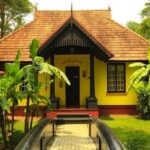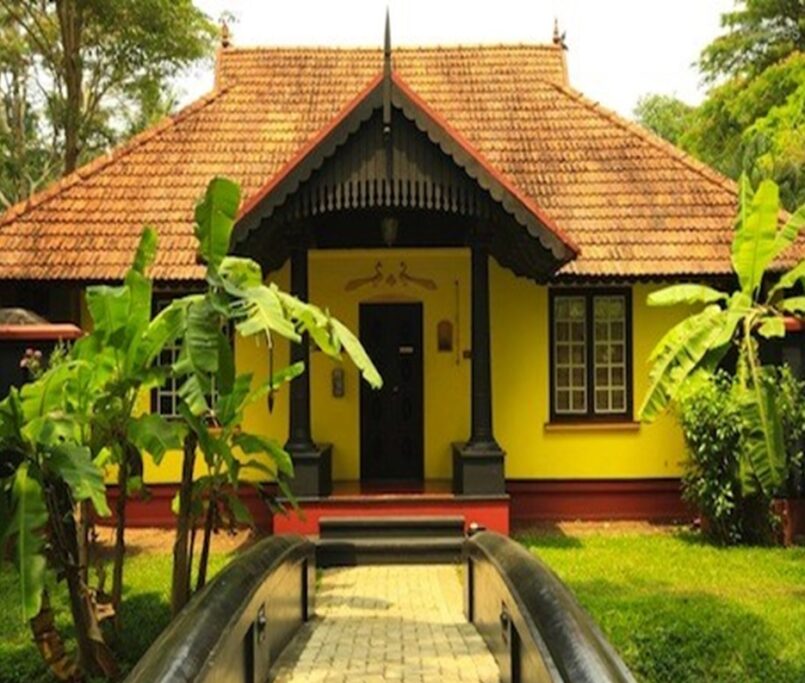Reviving Ancient Construction Technique of SESMIC Zone V
Abstract— This paper aims to establish an understanding of the of ancient construction technique used in Himachal Pradesh and Jammu and Kashmir with respect to its climate and earthquake seismic zone.
One case study of Himachal Pradesh and One of Jammu and Kashmir is taken to understand its construction techniques with respect to climate and Earthquake.
This paper provides detail analysis of both zone in terms of tangible and intangible aspects and also provide suitable replacement of the materials.
HYPOTHESIS: How traditional materials and construction techniques could be used in today’s time to reduce risk factor of earthquake.
INTRODUCTION-
Our past has a significant influence on our future. The antique technology that our forefathers used are incredibly iconic. There was an ecological balance maintained between the human and natural environments in the beginning. When every heritage structure is considered, a common element that appears to be distinct is its construction approach and structural stability, which has ensured its survival even in the face of natural disasters, man-made disasters, and ignorance.


After the 2005 earthquake that impacted several parts of Kashmir in both Pakistan and India, there was a huge amount of damage, and it was found that in the middle of the urban jungle, a hidden gem captured the attention of the entire world since it withstands even after such a dangerous earthquake that’s about 7.6 Mw to 9 Mw and caused up to 86000 accidental deaths.
NEED FOR STUDY-
- As in Today’s era ancient building is still standing stall after so many climatic effects.
- Some techniques are well known but there is lots of hidden gems which differ from different regions.
- This hidden gem can be used in similar climatic zone
AIM- To study how traditional materials and construction techniques could be used in today’s time to reduce risk factor of earthquake.
OBJECTIVE-
- Construction techniques of similar areas.
- Advantages and disadvantages, it’s uses.
- Suitable replacement of material
CASE STUDY-
- OLD JUBBAL-KATH KUNI
- SRINAGAR HOUSE-DHAJJI DEWAR
PARAMETERS-
- CLIMATIC REGION.
- EARTHQUAKE ZONE.
METHODOLOGY-

KATH-KHUNI ARCHITECTURE
Kath khuni is an indigenous technique of building with wooden stones, used by all types of vernacular-built forms in the Sutlej valley of Himachal Pradesh. Kath Khuni buildings have increase rapidly to their mountainous terrain that is prone to earthquakes because of their essential strength, flexibility and stability. Stone forms the entire plinth. Two parallel layers of stone make up the structure. The gap in the middle is filled with random rubble, depending on the size of the stone. The style plays an important role in the lifestyle of the locals. Kathkhuni architecture evolved from the need to survive in extremely harsh climates. In order to do so, the climate requires a very sustainable, energy-efficient and functional building. This is where sustainability becomes a necessity. The need for sustainability has developed a unique design for the building.

Construction details
Kath-Kuni walls are built with layers of alternating stone masonry and timber beams. As a result of the well-shaped ashlars on the dry-stone masonry, the building in the case study is quite attractive. Two parallel timber beams are placed on top of the dry-stone masonry. A maanwi (timber dovetail connection) connects the parallel timber beams and they are spaced about one meter apart. Parallel timber beams are held together by maanwi’s.
Over the height of the structure, Kath-Kuni corners are connected by continuous timber ties. The stacked timber beams are connected with kadils (timber dowels) in the corners. However, the amount of stone in between two timber layers can vary between different buildings. Corner kadils (timber dowels) connect timber beams stacked on top of one another. Stone can be found between several different layers of timber, but the amount varies.
Adding timber infill pieces in the corners will allow the height of the layer (which consists of one timber layer and one stone layer) to increase. Consequently, the structural integrity of the timber can be maintained while using less timber. According to the locals, larger buildings require





DHAJJI DEWAR
Dhajji Dewar is a type of traditional architecture that can be found in both India and Pakistan occupied Kashmir. Similar structures can be found in the United Kingdom, France, Germany, Central and South America, Turkey, Greece, Portugal, and Italy, as well as other Eastern European countries.
Dhajji uses wooden frame diagonals of lumber, and the spaces between the braces or frames are filled with stone/bricks to form a thin wall, which is commonly plastered with mud mortar from both the inside and outside.
The Dhajji is normally built on a shallow stone foundation, with a structure that is only 1-4 storeys tall if the lowest level is constructed using the TAQ technique, and a flat timber and mud roof, or a pitched roof with timber/metal sheeting.
The ‘Dajji Dewar’ is a significantly thinner and lighter type of wall that is made up of timber framing with brick/stone infills. The ‘dajji dewar’ has more ductility and damping. Furthermore, the timber’s horizontal and vertical cages are braced diagonally against shear. This cross element, which is normally found at the corner, provides shear resistance to the entire framing. Shear cracks aren’t allowed to spread because the timber studs Plinth Wooden frame Infill stone Roof Cow shed First floor Ground floor Paper Code: SPA-103 are close together. The upper-level stone walls are also broken up into smaller numerous panels, each of which is independent as a result of this framing. The failure of any one panel will not cause the entire wall to collapse, and so the entire structure will not collapse. Small masonry panels encircled by timber parts are more resistant to out-of-plane collapse

TANGIBLE ASPECTS-


INTANGIBLE ASPECTS-

TECHNIQUE COMPARISION

COMPARING WITH OTHER MATERIAL

RESULT/CONCLUSION
BY ABOVE CASE STUDY ANALYSIS IT IS FOUND THAT TYPOLOGY OF CASE STUDY ARE SIMILAR BUT KATH-KUNI IS ALSO USED IN MANY TEMPLES ACROSS HIMACHAL PRADESH
- INTERMS OF SCALE KATH-KUNI CAN BEAR’s MORE FLOOR LOAD AS IT CAN GO UPTO FIVE STORIE BUT DHAJJI DEWAR CAN ONLY GOES UPTO TWO STORIE IF IT PURELY MADE UP OF Its OWN KIND.
Paper Code:SPA-103 - BY STUDY IT IS FOUND THAT KATH-KUNI IS ONLY USED IN HIMACHAL PRADESH AND IT CAN USED IN AREA WHICH IS SIMILAR TO HIMACHAL PRADESH IN TERMS OF CLIMATE AND EARTHQUAKE SESIMIC ZONE.
- BY USING KTH-KUNI IN OTHER REGION, “THE VANISHING TECHNIQUE CAN BE REVIVE AND BECOME An EARTHQUAKE RESISTANCE STRUCTURE IN REGION OF KASHMIR, SIKKIM, ARUNACHAL PRADESH ETC.”
- AS KASHMIR, SIKKIM, ARUNACHAL PRADESH LIES EARTHQUAKE SESIMIC ZONE IV AND V THE NEED OF SUCH A TECHNIQUE WHICH CAN RESIST EARTHQUAKE IS MUCH NEEDED THERE.
- AS USING WOOD BECOMING DEFICULT, WOOD CAN BE REPLACED BY BAMBOO AND HEMP.
ACKNOWLEDGMENT
This work was supported by following person they Ar. Akanksha Modi (Poornima University-Jaipur), Ar. Keyur shah (Surat), Er. kubilay hicyilmaz, Prerana Chandak & Mansi Aggarwal (Poornima University.
REFRENCES
Ali, A. T. S. a. P. D. Q., 2009. DHAJJI CONSTRUCTION, Switzerland: supsi.
Alquizalete, B., 2020. [Online] Available at: https://findanyanswer.com/what-are-the-six-seasons-in-english
Ar. Mayuri Deshmukh, A. P. A. S. K., 2016. Analysis of Inherent Sustainability of Kath-Kunhi Architecture, Old Jubbal, Himachal Pradesh. International Journal of Research in Civil Engineering, Architecture & Design Volume 4, Issue 2, pp. 74,75,76.
Chakraborty, R., 2019. WORLD ARCHITECTURE. [Online] Available at: https://worldarchitecture.org/article-links/eepfe/ancient-construction-techniques-of-india-a-regional-study.html
Chakraboty, R., 2019. world architecture. [Online] Available at: https://worldarchitecture.org/article-links/eepfe/ancient-construction-techniques-of-india-a-regional-study.html
Dey, R., n.d. Is India Hot or Cold? All You Must Know!. [Online] Available at: https://indiaview.co/is-india-hot-or-cold/
Kubilay Hicyilmaz, J. K. B. M. S., 2011. HOUSING REPORT, Kashmir: World Housing Encyclopedia.
Tayyibji, V. a. R., 2008. The Kashmir House its Seismic Adequacy and the Question of Social. Beijing, China, Professor, Faculty of Architecture & Faculty of Building Science and Technology, CEPT University, pp. 3,4,5.
UNESCO, P. D. o. I. t., 2015. Cold Desert Cultural Landscape of India. [Online] Available at: https://whc.unesco.org/en/tentativelists/6055/
Zanden, M. L. v. d., 2018. Assessment of the seismic performance and sustainability of the Kath-Kuni building style in the Indian Himalaya, Delft, Netherlands: Tu Delft.










